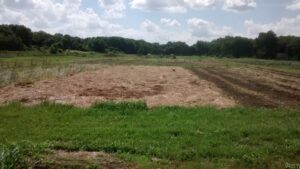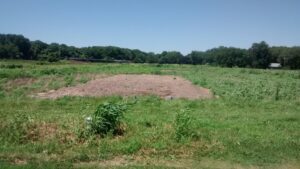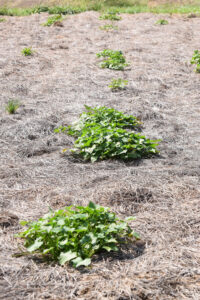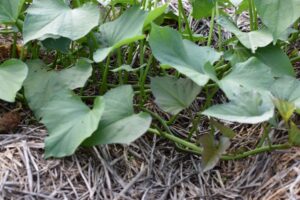2016 Annual Report for FNC16-1029
Exploring the Economic and Environmental Sustainability of No-Till Organic Sweet Potato Production
Summary
I established a quarter acre trial plot split into three equal sections. In one section I established a cover crop of winter peas and rye, in the second section I spread seven bales of straw, and the third section I used as the control and tilled and managed in my conventional manner (with a 6’ rototiller behind the tractor).
At the end of May I rolled the cover crop using the roller on the rear of my flail mower. Into each of these sections we planted six rows of sweet potatoes of two cultivars- four rows of Beauregard and two rows of Bonita. The rows were cultivated as needed and able. This consisted of two passes with tractor cultivation in the control plot, until the vines had run too much, and a final pass by hand.
The rolled cover crop plot and straw mulch plot were weeded by hand, although the straw plot required very little weeding throughout the season, due to the density of the mulch. After a light frost in October the sweet potatoes were harvested by hand and weighed. At harvest the crops were sorted for damage from mice/voles and other causes and assessed for percentage of marketable sweet potatoes.
The results look pretty grim for both of the no-till trials. The conventional tillage plot was so much easier to plant, maintain and had a much greater yield. Part of that is certainly due to the fact that I am experienced and equipped for the conventional tillage system, but it is hard to overlook the massive discrepancies in yield. The surprising result is the higher proportions of marketable crops in the no-till systems.
I feel that in the this first year, the rolled cover crop was the best compromise, but it provided challenges that might persist. The lack of ability to easily control weeds seems to be a critical challenge for rolled cover crop based systems. We had difficulty establishing sweet potatoes in the straw mulch, as the mulch can become very hot under the summer sun and that tended to desiccate and kill tender slips. Additionally, this year my farm faced more deer pressure than it had in the past, and the straw mulch provided a unique opportunity for the deer. The straw mulched area was particularly weed free, so the deer were able to focus on eating the tender and tasty sweet potato leaves, and frequently grazed this area.
Objectives/Performance Targets
The objectives of this project are as follows:
- Determine the feasibility of organic no-till production systems for sweet potato production in Northeast Kansas.
- Produce crop enterprise budgets for each of the 3 production systems being evaluated
- Compare the soil health benefits of each system based
Accomplishments/Milestones
Work Activities
I established a quarter acre trial plot, split into three equal sections.
In one section I established a cover crop of winter peas and rye, in the second section I spread seven bales of straw, and the third section I used as the control and tilled and managed in my conventional manner (with a 6’ rototiller behind the tractor).
At the end of May I rolled the cover crop using the roller on the rear of my flail mower. Into each of these sections we planted six rows of sweet potatoes of two cultivars- four rows of Beauregard and two rows of Bonita. The rows were cultivated as needed and able. This consisted of two passes with tractor cultivation in the control plot, until the vines had run too much, and a final pass by hand. The rolled cover crop plot and straw mulch plot was weeded by hand, although the straw plot required very little weeding throughout the season, due to the density of the mulch. After a light frost in October the sweet potatoes were harvested by hand and weighed. At harvest the crops were sorted for damage from mice/voles and other causes and assessed for percentage of marketable sweet potatoes. Grant funds for this year went to covering the straw bales, sweet potato slips and labor for carrying out the project.
Impacts and Contributions/Outcomes
Results and Lessons Learned
 Early season overview
Early season overview
 Mid-summer overview
Mid-summer overview
 Straw-mulched sweet potatoes
Straw-mulched sweet potatoes
 Mulched sweet potatoes
Mulched sweet potatoes
The yield results are as follows expressed as Pounds harvested per cultivar:
| Good (lbs) | Bad (lbs) | Percentage Marketable | ||
| Section 1 -Control | ||||
| Beauregard | 266.40 | 101.9 | 72 | |
| Bonita | 124.92 | 32.78 | 79 | |
| Section 2- Straw Mulch | ||||
| Beauregard | 18.74 | 1.66 | 92 | |
| Bonita | 2.94 | 0.54 | 84 | |
| Section 3- Rolled Cover | ||||
| Beauregard | 79.76 | 19.32 | 81 | |
| Bonita | 22 | 0.8 | 97 |
The results look pretty grim for both of the no-till trials. I have heard from no-till advocates in the row crop arena that there is a five year window where yields are depleted as the soil rebuilds the biota needed to make no-till successful.
In spite of this knowledge, this project tested my commitment to soil health building through reduced tillage. The conventional tillage plot was so much easier to plant, maintain and had a much greater yield. Part of that is certainly due to the fact that I am experienced and equipped for the conventional tillage system, but it is hard to overlook the massive discrepancies in yield.
The surprising result is the higher proportions of marketable crops in the no-till systems. My initial hypothesis was that the mulch would offer idea situation for pests, moles, voles and mice, so that they would have a higher bad percentage than the control.
Here are my current thoughts on the two no-till systems I experimented with. I feel like the rolled cover crop was the best compromise, but it provided challenges that might persist. I felt that I had established a good cover over 90% of the trial space with a solid stand of rye between 5-6 feet tall interspersed with peas. I realized I was wrong a while after rolling the crop and planting the sweet potatoes, when weeds became rank in that field. At this point, the rolled-cover “no-till” option becomes a hindrance to the ability to use mechanical weeding. There is enough mulch and debris to hinder tractor cultivation or even hand hoeing, but not enough to effectively suppress weed growth. We tried to do our best weeding by hand, but some weeds, especially Johnsongrass (Sorghum Halepense) became established in this section. This will provide an ongoing challenge to using this space in the future. The lack of ability to easily control weeds seems to be a critical challenge for rolled cover crop based systems.
I also learned a lot about straw mulching. We had difficulty establishing sweet potatoes in the straw mulch, as the mulch can become very hot under the summer sun and that tended to desiccate and kill tender slips. Additionally, this year my farm faced more deer pressure than it had in the past, and the straw mulch provided a unique opportunity for the deer. The straw mulched area was particularly weed free, so the deer were able to focus on eating the tender and tasty sweet potato leaves, and frequently grazed this area. This limited plant growth significantly. Finally, straw being a good insulator, the sweet potatoes plants there died much earlier than the non-mulched area. The leaves seemed to be insulated from the warming effects of the soil, so a very light frost, which normally provides a bit of leaf burn to the other plants terminated the sweet potatoes on the straw section. While this was too late in the season to limit growth it was an interesting observation.
In addition to the production method specific insights, I learned a number of other lessons through this project. First and foremost, I realized my project plan had a few flaws in design, in that a few challenges changed some of the proposed procedure. At critical points in the season I was short staffed, due to the departure of a long-time employee. As a result, I failed to conduct the initial soil test in a timely fashion so the soil testing component will be added in year 2. Additionally, I did not budget adequately for the no-till planting aid, so I did not build one this year. I have been trying to source used parts to make it economically feasible for year two. The result of this was that planting in the no-till plots was more labor intensive than it probably should have been.
Work Plan for next year
In 2017 I plan to replicate the work I did in 2016. As a result of some failures in the project I am spending extra time to make sure timely soil tests occur and that there is some sort of no till planting aid available to assist planting. In addition to growing the sweet potatoes in a controlled way I will also focus on outreach, as I now have some data, and observations to present.
Outreach
I only shared information to people I was in contact with in 2016. This is a group of about 6 farmers. I decided that there was not too much to show others, as I had no relevant data until the end of the year. I decided to postpone my field days until I had more significant information to talk about. Going forward in 2017, now that I have some data, I will be able to start outreach more effectively. I plan to have two field days in 2017, and I am currently working on an addition to my website that will promote the information I have gathered.